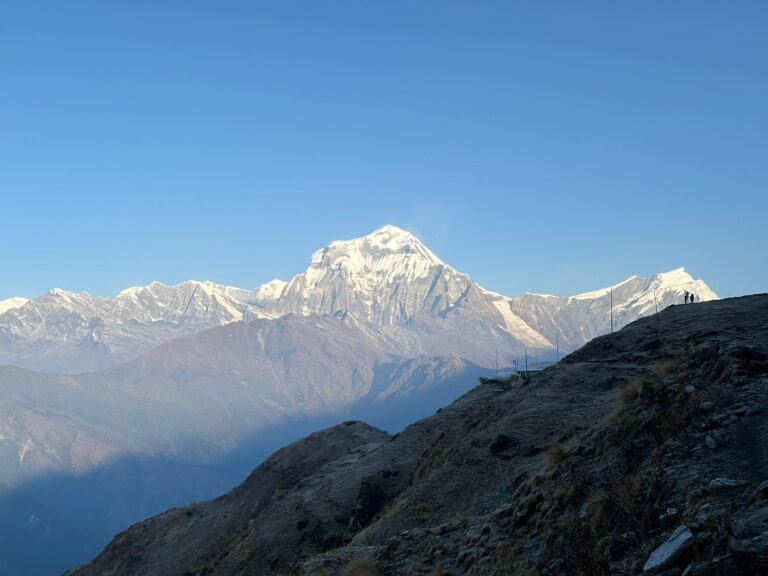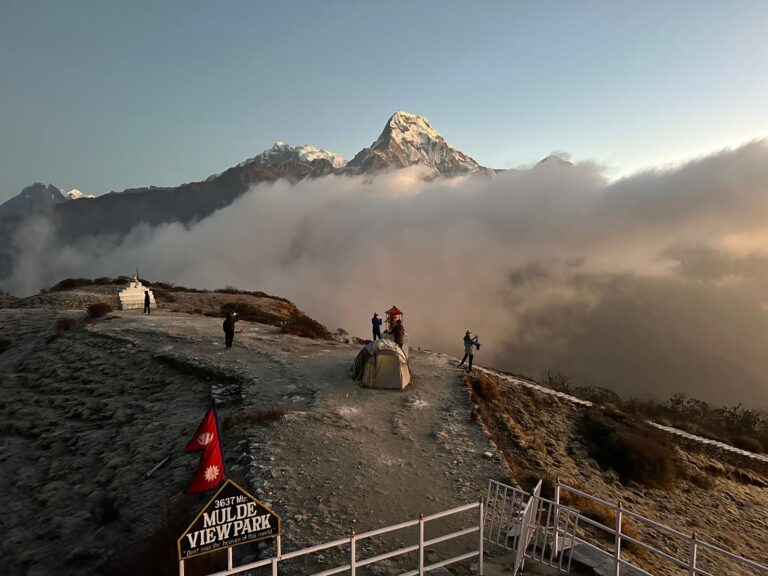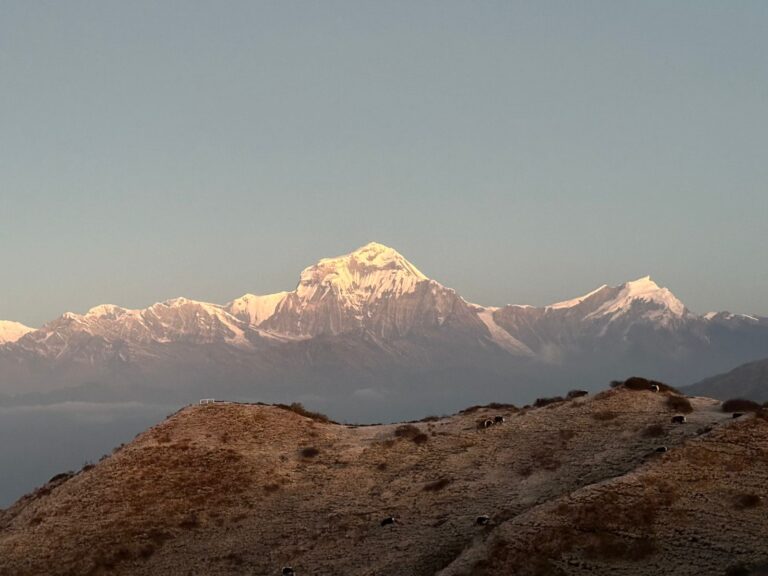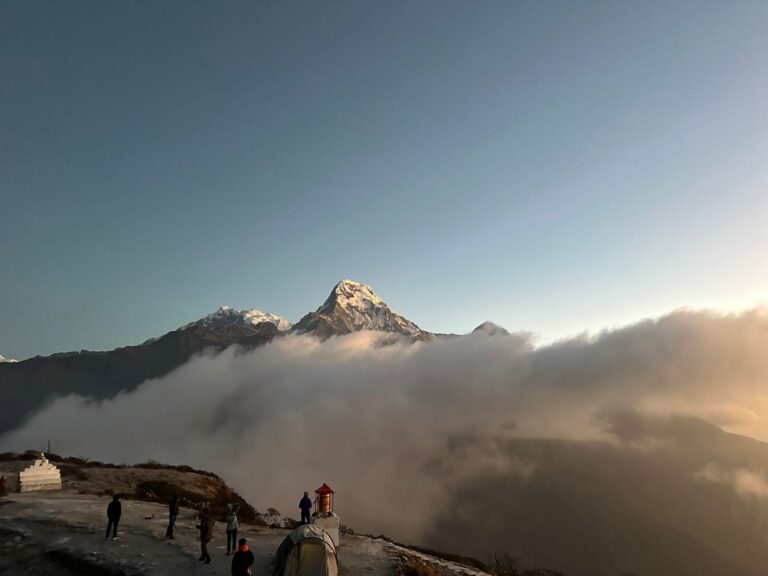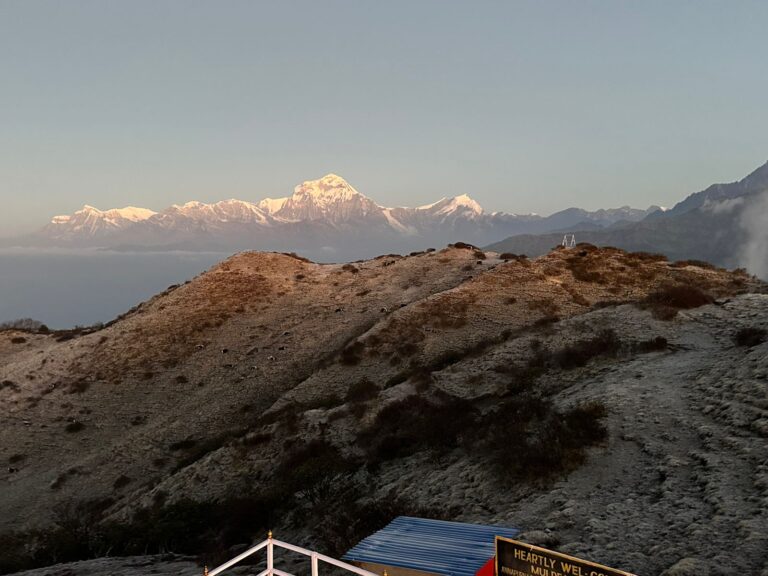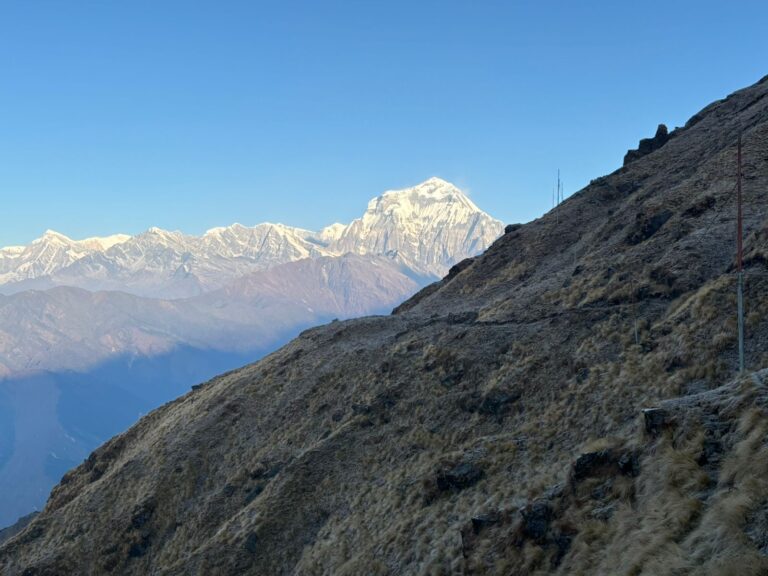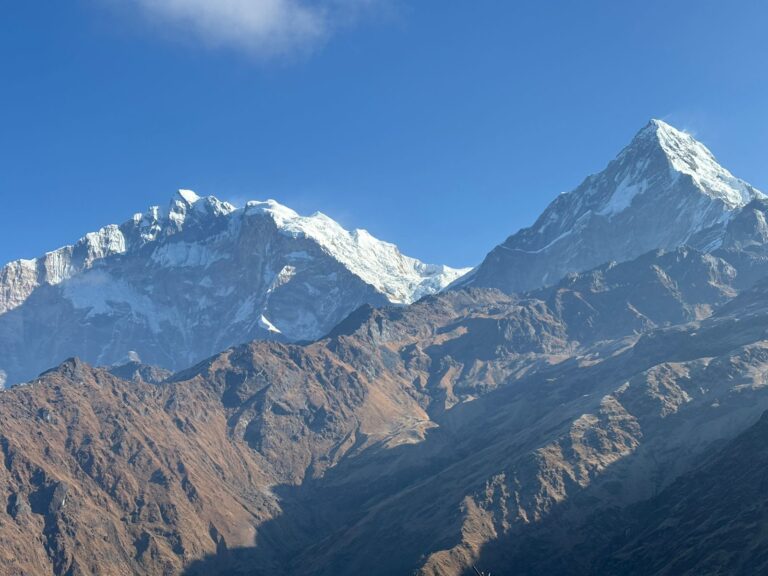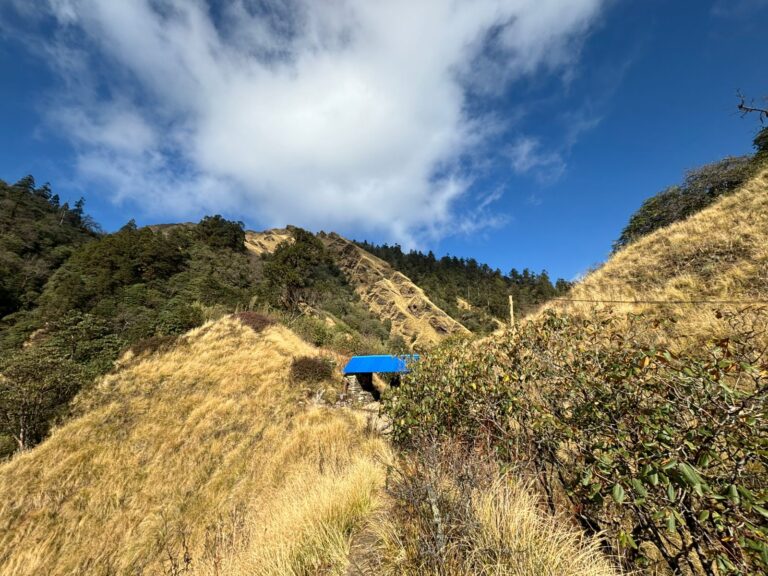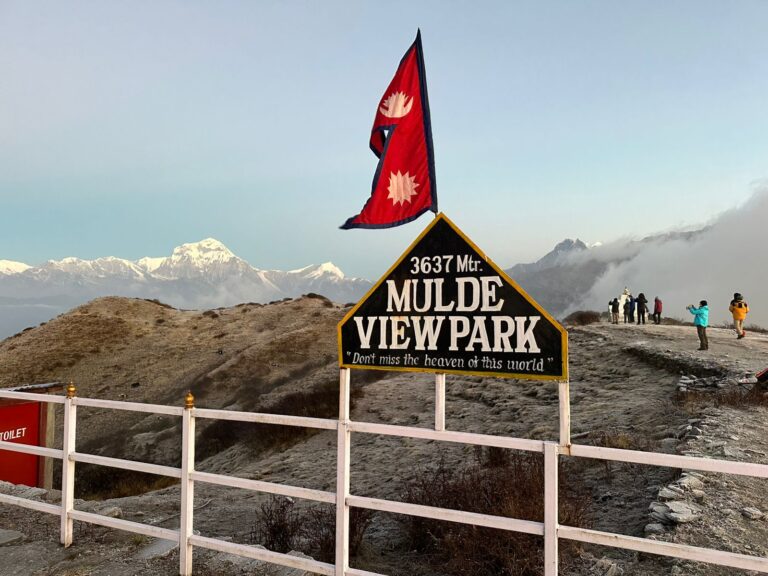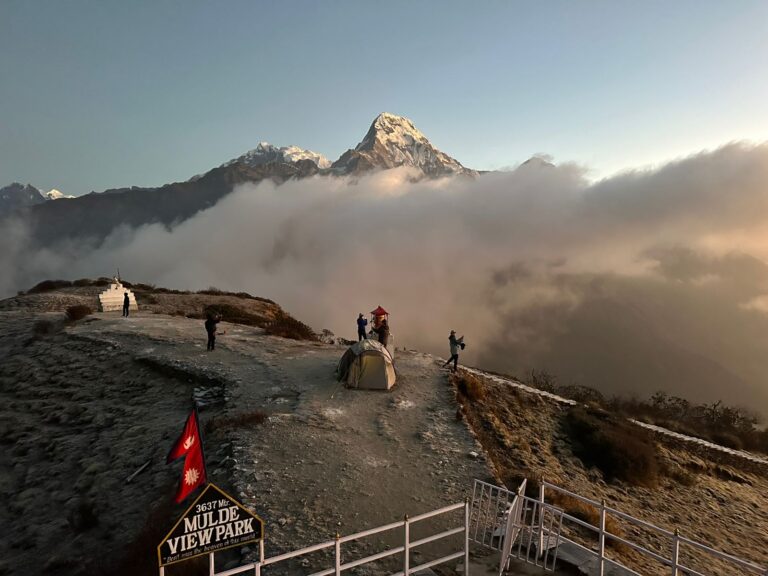Khopra Ridge Trek
-

Trip Duration 10
-

Max, Altitude 3660m
-

Type Standard
-

Best Season Sept-June
-

Meals Included
-

Accommodation Included
-

Activity Hiking
-

Difficulty Easy
- Experience the excellent view of the Annapurna and Dhaulagiri ranges, including the Annapurna South, Machapuchare, and Dhaulagiri ranges.
- It passes through less popular, quiet routes, always ensuring visitors have quality time with nature without so many tourists.
- In these villages, Ulleri and Swanta, trekkers can experience the local culture and experience the hospitality of the Gurung and Magar people.
- Khopra Ridge, 3,660 m high, offers one of the area’s most spectacular sunrise and sunset views.
- An optional side trek to the sacred Khayer Lake, at the base of the Annapurna massif, offers a spiritual and beautiful experience.
The Khopra Ridge Trek is an off-the-beaten-path trekking destination in the Annapurna region of Nepal. It has stunning views of the Annapurna and Dhaulagiri mountains and is less crowded than other trekking regions.
Overview of Khopra Ridge Trek
Khopra Ridge Trek combines nature and culture through dense forests, remote villages, and alpine landscapes. This trek starts in the beautiful lakeside town of Pokhara and slowly winds through forests of rhododendrons and paddy fields.
During the trek, you can explore the Gurung and Magar villages and experience their warm hospitality, authentic lifestyles, and customs.
The highlight of the Khopra Ridge Trek is the Khopra Ridge, from which you can see the Annapurna range, Annapurna South, Dhaulagiri, and Machhapuchhare mountains.
The Khopra Ridge Trek also provides a calm and much less crowded place for trekkers to view the Himalayas.
Trekking is not very difficult, making it a perfect challenge for beginners. It usually lasts 7 to 9 days, and the highest point is 3,660 meters at Khopra Ridge.
The best times for Khopra Ridge Trek are spring and autumn because there is always good weather and trekking conditions.
The Khopra Ridge Trek is ideal for everyone who wants to experience something remote and extraordinary, amazing views, and unique encounters with local people.
Khopra Ridge Trek Difficulty
The Khopra Ridge Trek’s difficulty level is comparable to other moderately tricky treks, so you should prepare for hiking at high altitudes.
The Khopra Ridge Trek route has a steady ascent; depending on the chosen path, trekking takes 5 to 7 hours daily.
Although the altitude ascends gradually, with the highest point of the trek at 3,660m, Khopra Ridge, trekkers should expect simple physical challenges that manifest in mild breathlessness and tiredness.
Trails are easy to follow, though somewhat rugged in some parts as you progress through the area during the final ascent into the ridge. It has trails through forests that occasionally become rocky and exposed slopes.
Not only is it difficult to trek the area, but there are also very few facilities and medical help is scarce in the unlikely event of illness or accident.
Trekkers should dress well and be well prepared. Wear appropriate clothing that will make you feel comfortable, and drink a lot of water.
Short Itinerary
Itinerary of Khopra Ridge Trek
The first day of the Khopra Ridge Trek will be spent at 1,350 meters in Kathmandu. In the evening, you will be taken to your hotel, as you have some movement ahead in the morning. Sleep early, wake up in the morning, and familiarise yourself with the city’s ambience.
In the evening, you can be alone, move around, and visit other places, or have dinner in relative calm. The day is for resting and grooming yourself for the warfare that is to follow.
- Hotel Arts Kathmandu ( 3 star)
Today, our first tour day, we will drive to Pokhara, which will take approximately 7- 8 hours from Kathmandu. During the drive, we will have great opportunities to see the rivers, hills, and countryside scenery.
As we approach Pokhara, you will get lovely views of typical Nepali villages and the gradual change in the topography. After that, living accommodation and once you are settled into the hotel, you can start your trip. The evening can still be spent wandering around the calm Phewa Lake or in the hotel.
- Hotel Queens Park ( 3 Star)
- Breakfast, Lunch and Dinner Included
This is a driving day since our destination for the day, Ghandruk (1940m), is approximately 3-4 hours away by drive.
From Ghandruk, you travel for five hours to Tadapani, which is 2,630 meters above sea level. This trail winds through forests, allows you to cross a few streams, and allows you to photograph magnificent waterfalls.
During this part, we can see the picturesque mountains such as Annapurna and Machapuchare. For instance, you will use a local guesthouse where you will be spending that night and witness the serenity of the surrounding region.
- Local Guest House
- Breakfast, Lunch and Dinner Included
Today, we will start our journey to Dobato again, which will take approximately 6-7 hours on foot. The trail through the mountain has dense rhododendron trees, sometimes with glimpses of white peaks.
Gradually we progress further, the view becomes more attractive, one can see a glance of Annapurna mountain range. The trek is not easy, but it is worth it. Later, when we move to Dobato, we will spend a night in a guest house enjoying the serenity in that region.
- Local Guest House
- Breakfast, Lunch and Dinner Included
The next day, we will walk from Mulde’s viewpoint at 4,310m to Chistibung at 3,026m, which will take us 5/6 hrs. The viewpoint known as Mulde Viewpoint is one of the best view finders to the Annapurna and Dhaulagiri ranges of the trek.
The trail is scenic since you will likely come across the forests and massive ridges. After arriving at Chistibang, you will have ample leisure time to watch and admire the beauty of the mountain. This night will be spent at the guesthouse, allowing the hiker to relax and think through the day’s hike.
- Local Guest House
- Breakfast, Lunch and Dinner Included
On Day 6, the ultimate part of the trekking, we go to Khopra Danda at a height of 3,640 meters, which takes 5-6 hours. Khopra Danda is optimized with spectacular views of the Himalayan range comprising the south of Annapurna and Dhaulagiri, among others.
The trail leads us past marshy areas of alpine meadows and provides a view of the area’s wildlife. After we get to Khopra Danda, you can find some time to relax along with the beautiful views of the mountains: one-day and one-night accommodation in a guesthouse.
- Local Guest House
- Breakfast, Lunch and Dinner Included
On this seventh day, we trek from Khopra Ridge at 2,510 meters to Swanta Village at 2,200 meters. The trek involves crossing forests and hills with beautiful terraced fields and meandering through small villages, so you can see quite a bit of village life.
Swanta is a beautiful village to visit, and you can offer yourself the chance to relax and go around the town. Within the guesthouse, there is overnight accommodation.
- Local Guest House
- Breakfast, Lunch and Dinner Included
On Day 8 of the Khopra Ridge Trek, the participants left Swanta Village to reach their Ghorepani destination, at 2,880 meters. This trip of about 10 kilometres took 5-6 hours.
As with many trails in this area of the country, the path features beautiful rhododendron cover and breathtaking views of the mountains.
The last part of the trek from Tadapani to Ghorepani is less deceptive. Before reaching Ghorepani, you get a great view of the Annapurna and Dhaulagiri ranges.
Ghorepani is somewhat famous as a trekking point where one can feel welcome and admire the stirring atmosphere of the place—accommodation in a guest house with a family.
- Local Guest house
- Breakfast, Lunch and Dinner Included
This involves an early morning trek to Poon Hill, which is at an altitude on 3,210 meters to view hill ranges while sunrise. There are majestic views to capture through camera, and upon the descent to Banthanti it takes 4-5 hours to complete the 6 km trek.
From there you have a ride back to Pokhara where you have your leisure time and last night stay in this beautiful city. Accommodation in a hotel in Pokhara- Overnight.
- Hotel Queens Park ( 3 star)
- Breakfast, Lunch and Dinner Included
Today you will drive back from Pokhara to Kathmandu. The road condition is most of the parts good. The drive is around 6-7 hours. In between we will stop for our lunch.
- Hotel Arts Kathmandu ( 3 star)
- Breakfast Lunch and Dinner Included
The trek ends at the day 11 where you will say goodbye to Nepal. Have a safe and great journey ahead.
- Breakfast Included
Price includes
- Kathmandu airport transfers on a tourist vehicle
- Twin-sharing/double accommodation in a 3-star hotel in Kathmandu and Pokhara for 2 nights each including breakfast
- Twin-sharing or dormitory guesthouse accommodation during the trek in the Annapurna region for 8 nights
- Standard meals (breakfasts, lunches, and dinners) during the trekking days
- Tea and Coffee in each meal time during the trek
- Experienced, first-aid trained, government licensed, English speaking Guide
- Permits for Annapurna Conservation
- Porters during the trek for carrying luggage (1 porter for every 2 clients)
Wages, accommodation, meals, gear, insurance - Boating in Phewa lake with guided tour to Barahi temple After the trek
- Tourist bus between Kathmandu and Pokhara and back.
- Private tourist vehicle from Pokhara to Ghandruk and Hile to Pokhara
- Himalayan Trekking’s duffel/kit bag, trekking map, and trip completion certificate
- A farewell dinner on the last night in Nepal
- All administrative expenses and government taxes
Price Excludes
- Meals (lunch and dinner) in Kathmandu and Pokhara
- International flight fare and airport departure tax
- Any beverages including bottled and boiled water
- Travel insurance along with high-altitude emergency evacuation coverage
- Tips to trekking staff and driver
- Nepal Entry Visa (Visa can be acquired easily after your arrival at Tribhuvan International Airport in Kathmandu with a fee of USD 50 for 30 days visa and USD 125 for 90 days visa)
- Personal Trekking gear and equipment
- Any expenses other than the Price Include section
Have any Questions? Check out FAQ'S
Trip Essential Information
Altitude Sickness during Khopra Trekking
Altitude sickness is also a risk during Khopra Ridge Trek and once reaching higher altitudes such as Khopra Ridge (3,660m).
Symptoms such as headache, dizziness, vomiting, and shortness of breath may occur. To avoid some of these risks, it is suggested that you acclimatize appropriately on the trail.
Walking steadily, drinking water, avoiding alcohol, and eating mild meals can also prevent altitude sickness.
If health keeps deteriorating, it is necessary to go down and consult a doctor.
Food During Khopra Ridge Trek
The food during the Khopra Ridge Trek is plain and wholesome, mainly made with locally available products.
The food that trekkers will be served during the trek includes dal Bhat, a lentil soup with rice; momo is also an option, a type of dumpling; and noodles and vegetable curry are also served.
Tea houses Along the road offer Western food, such as pancakes, pasta, soups, etc., to suit different people’s preferences.
Despite that, the food is often heavy in calories, maybe plain and sometimes bland, especially in remote areas. Food options are scarce, and there are only fresh fruits and some snacks, so bringing an energy bar or trail snack is advisable.
Local vegetables like potatoes and dairy products like curd are readily available, complementing the trekking’s nutritional values. Nevertheless, as we trek higher, foods are slightly scarce, and the prices tend to be steep.
Accommodation during the Khopra Danda Trek
Stay on the Khopra Ridge Trek comprises tea houses that provide basic but comfortable shelters on this trip. Most of these tea houses are managed by families and offer trekkers a cozy place to have meals and relax.
Accommodation is relatively simple: wooden beds, blankets, and shared bathroom facilities. The facilities in the more rural areas are even more straightforward, with fewer services, but all necessary facilities are provided.
Tea houses also act as social places and platforms for trekkers during a trek. Here, you can get good food, share a story or two with fellow trekkers, and learn about local culture.
Rice, dal bhat, wheat noodles, pasta, and momos (steamed or fried dumplings) are affordable. However, sleeping options are scarcer higher up, and it’s always wise to book beforehand, especially if you plan to trek when most other tourists are also hiking.
The higher you go, the more limited the facilities are; some tea houses have only simple rooms.
However, the basic lodges associated with these treks are part of the overall trekking experience to understand some of the local people’s existence truly.
Typical Day on Khopra Trek
A typical day on the Khopra Ridge Trek begins early, with trekkers waking up around 6:00 AM to start the day. After a warm cup of tea, breakfast is usually served around 7 am at the tea houses.
Breakfast includes local meals such as different types of porridge, eggs or pancakes. Since the trekkers need energy for the rest, nutritional foods are added.
The trek begins around 8:00 a.m. after breakfast. It involves moderate to challenging hikes, with walking times between 5 and 7 hours daily.
The trail has some ascents and descents, and for the most part, it passes through dense forest. En route, trekkers set some time aside to allow them to relax, eat and drink water and enjoy the beauty of the mountains.
Lunch is often eaten at around 12 or 1 p.m., usually at a tea stop on the way. The food is basic and filling, offering a chance to relax before continuing the hike the next day.
After lunch, the trek continues to the higher-altitude teahouses, the day’s final destination. Depending on the trekking schedule, trekkers arrive at their final destination by 4 or 5 p.m., rest, and have a meal.
The evening is spent socializing with fellow trekkers or resting and lights out around 9 PM for the next day’s event.
Khopra Ridge Trek Permits
To trek the Khopra Ridge, you will need two essential permits:
Annapurna Conservation Area Permit (ACAP):
This permit is used to trek the Annapurna Conservation Area, where the entire Khopra Ridge Trek trail is located. It also aids in maintaining and conserving the region’s natural scenery and fauna. The ACAP can be issued in Pokhara or Kathmandu.
Trekkers’ Information Management System (TIMS) Card:
All trekkers must have a TIMS card for security reasons and to register their location while on a trekking tour. This ensures that every trekker is registered and can always be rescued. The TIMS card is available in Kathmandu or Pokhara.
Both permits can be obtained at the Tourist Service Centre in Pokhara or the Nepal Tourism Board in Kathmandu. The price for both licenses is not very high, and it differs only between foreigners and citizens of SAARC countries.
They need to show the required permits throughout the trek, which means ensuring you carry them during each checkpoint on the route is essential.
Travel Insurance
It is necessary to make Travel Insurance for the Khopra Ridge Trek to cover oneself against unforeseeable hazards during the trek.
The policy should cover all medical expenses during the trek, such as injuries, illnesses, and altitude sickness. Medical evacuation coverage is critical, as rescue by helicopter from high altitudes may become unavoidable in accidents.
Furthermore, insurance coverage should be applied mainly to trekking at extreme altitudes (exceeding 3,000 m) since Khopra Ridge is at an elevation of 3,660 m.
Trip interruption or cancellation should also be covered by unforeseen accidents that occur, for example, due to some disease or travel disruption. Personal liability protection and coverage for lost, damaged or delayed personal baggage and equipment should also be provided.
Before purchasing, it’s crucial to compare policies and confirm that the insurance provider covers trekking activities in Nepal, especially for routes like Khopra Ridge, to ensure enough protection throughout your trek.
Khopra Ridge Trek Cost
The Khopra Ridge Trek costs USD 950 to 1250 per person, covering all significant expenses for the journey.
The Khopra Ridge package also covers the permit fees (Annapurna Conservation Area Permit and TIMS card), meals (breakfast, lunch, and dinner), accommodation in the local tea houses, and transportation.
The cost helps trekkers avoid spending more cash on other things with extra charges since most of them are already included in the trek cost.
The Tea House is simple but comfortable. It offers breakfast, lunch, and dinner and serves local Tibetan and Western food.
The Khopra Ridge trek costs include transport to the beginning of the trek, such as by bus or car. This package has a fixed price, making it convenient for those who want a stress-free trekking experience.
Best Time for Khopra Ridge Trek
It is best to trek the Khopra Ridge during the spring (March to May) and autumn (September to November) seasons.
It must be noted that May, June, and October are the best months for trekking in this area in terms of weather conditions.
Spring usually offers a clear, warm, sunny climate, with rhododendron forests in bloom along the trail. Like summer, autumn is characterized by clear, sunny skies and stable temperatures.
It is even better for trekking due to the stunning view of the mountain. There is little or no possibility of rain. Both seasons are characterized by which makes the paths manageable and safe.
These are good trekking seasons as they experience comfortable weather with daytime temperatures ranging from 10-20 degrees C during the day and below 10 at night, especially towards the higher grounds.
Heavy rains occur between June and August, and the frigid winter lasts from December to February. However, spring and autumn are the best times for trekking and the best experiences.
Drinking Water
Safe drinking water is crucial during the Khopra Ridge Trek, so trekkers must take extraordinary measures. Bottled water is available for purchase at tea houses on the trail but is expensive and harmful to the environment.
Having a refillable water bottle and using water purification options such as a purification tablet, a filter, or a UV purifier is recommended.
Boiling water is also available in the tea houses; however, you must confirm that it is safe for drinking. You should always drink a lot of water to avoid altitude sickness, which is common in high places.
WIFI, Electricity and Communication
Wifi on Khopra Ridge Trek
WiFi can be available in a few tea houses at the lower trekking point, just above Pokhara, and at infamous stops like Tadapani.
However, due to the infrastructure of the designated region, the signal can be weak or unstable. There is no higher-up Wi-Fi, such as at and around the Khopra Ridge area. If you plan to stay connected, using Wi-Fi in Pokhara before or after the trek is best.
Electricity on Khopra Danda Trek
Teahouses provide electricity during treks, but it is generated using solar power. At lower altitudes, there is electricity for recharging devices, such as phone cameras or power banks.
When you climb up, the power supply might not be steady, and charging gadgets might cost a little more. However, charging may be challenging, so you should take spare power banks.
Communication on Khopra Trekking
Mobile phone signal strength is standard throughout the trek route but very weak in areas such as Tadapani, Ghandruk, and other base points. Nonetheless, there are certain inconveniences: the higher you ascend, the worse or non-existent the network signal often is.
In the higher areas, you may have to use satellite phones or wait for the tea house staff to inform you.
You can rent a satellite phone in Pokhara to stay connected in emergencies. However, due to the remote nature of the trek, internet and communication services can be slow.
In general, connectivity is possible from the middle heights, but be ready for poor connection when climbing higher into the mountains.
Frequently Asked Questions (FAQ)
Khopra Ridge trek can be best done during the spring season that is March-May and during the autumn period September-November. The weather is fine and the outlook is stunning.
The trek is considered to be moderate to difficult. It requires decent level of fitness since the trek involves steep climb, altitude changes and multi day hikes.
Trekking experience is helpful but it is not compulsory. Beginners with good health can trek throughout the route following proper altitude adjustment.
The trek typically takes 7 to 10 days, depending on the route and pace.
The highest point on this trek is Khopra Ridge at 3,660m (12,008ft). But if you also choose to trek to Khayer lake, the altitude is 4,660m.
Of course, a single traveller can do the trek, but it is safer and more comfortable to have an authorised guide or a group of trekkers.
While not mandatory, hiring a guide and porter is recommended for a smoother experience, especially for navigation and carrying heavy luggage.
Though it is perfectly possible to go it alone, trekking with a guide is always more comfortable and is advisable because the guide will help to choose a proper route and will know the area.
Risk of high altitude, change in climate and slippery trails are some of the danger factor. This is why much attention should be paid to acclimatization, as well as gentle trekking.
The trek mostly originates from Nayapul, which is five hours bus or jeep ride from Pokhara.
Of course, you can include the Khopra Ridge Trek into the package with some other treks in the Annapurna region, for instance, the Ghorepani Poon Hill Trek.
- Instant Confirmation
- Free to customize
- Support anytime
© 2025 - Himalayan Trekking and Tours (P) Ltd. All Rights Reserved.











